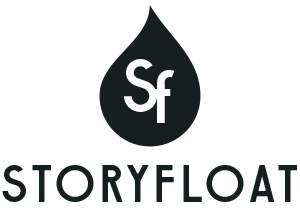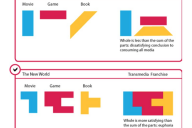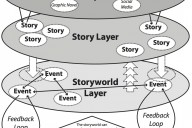When I reviewed the first Chapter of „Getting Started in Transmedia Storytelling“ by Robert Pratten, I excluded a certain part of the chapter due to the straightforwardness of the article. Now I want to recap this part and present to you the „7 Principles“ of Henry Jenkins.
At first, for those who have not heard of him, who is Henry Jenkins? Jenkins is a Professor of Communication, Journalism, Cinematic Arts and Education at the University of South Carolina. In 2006 he published „Convergence Culture: Where Cld and New Media Collide“, suggesting that trough the channels of new media, the barrier between producer and fan is somewhat compromised, resulting in a more viable interaction between those groups.
The 7 Principles also emanate from his work on fan culture: Pratten says, that „He is interested in how fans are rewarded by transmedia storytelling and what aspects of a transmedia storyworld create engagement and community. Robert Pratten describes to us his very own interpretation of those principles. I will now present you very shortly the seven dimensions and Prattens own interpretations:
Spreadability vs Drillability – Dimension
Spreadability refers to the simplicity of fans spreading content trough different kinds of media.
Drillability describes the possibility to explore the storyworld when getting more and more involved.
Continuity vs Multiplicity
Continuity speaks for itself. Does the story make sense, no matter how deep you get involved? Or are there some kind of crudities?
Multiplicity is given when the presented story is able to exist and be retold in an alternate universe.
Immersion vs Extractability
If you read the piece on escapism in Harry Potter, those are two aspects the Harry Potter haters would just have loved. If a story is immersive, you are able to sink into it while being in the „real world“. Extractability describes kind of the opposite: being able to „wrap the real world around the fictional storyworld“ (walking around with a wand, feeling like Harry Potter).
Worldbuilding
No matter where you look, you are captured by the fictional world. Remember when the new Star Wars came out? You where not able to even go on the internet without seeing another analysis of the trailer or featured video to promote the film. Those aspects to not necessarily tell the story in a conservative way, but they give you a broader understanding of the world.
Seriality
Seriality describes the act of cutting longer narratives into smaller bits, often distributed over several platforms. Pratten uses Alan Wake as an example: The Alan Wake Webseries tells the prequel to the Xbox Game from Alan Wake.
Subjectivity
How many characters in the story are able to share their own point of view? To create Subjectivity, minor characters often get another platform than the ‚Heros‘ to tell the story from their point of view.
Performance
Are fans able to contribute something to the story? And in what extent? Contribution can be the writing of Fan Fiction, making videos or meeting up for role- and cosplay.
This article is contributed by our author Jamin Schneider. Comments are very welcome.











1 Comment
[…] The seven principles of Transmedia Storytelling […]